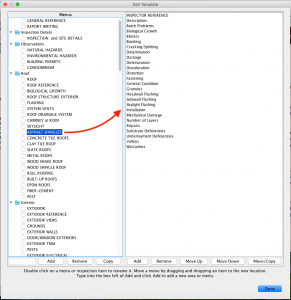SAVE A COPY! SAVE A COPY! SAVE A COPY!
The first thing you should do is to create a working copy which you can then edit saving the original in case you delete information that you would later like to retrieve.
Using the library efficiently is mostly about learning where things are and eliminating narratives that don't apply. If you were in Miami, you could eliminate all narratives that comment on snow. Reducing the size of the library will speed the process of finding narratives.
In order to more quickly become familiar with library organization (and to speed finding narratives), I recommend that, especially at first, you use the "Edit Template" function (button located in the toolbar). This will give you a better overview of headings and subheadings quickly.
Click to enlarge
This may also help you edit the organization in a manner that makes more sense to you. Regarding organization, I've done my best, but you can never please everyone. This approach will give an impression of what's generally available in the library.
You can then go to headings and subheadings in the normal part of the program and look through individual narratives, which are further separated by dotted lines and titles that help speed finding narratives by allowing you to look at narratives in groups of 4 or 5 (typically). It's much faster than having to read through a long, unbroken list of narratives. You can often recognize what you're looking for just by a glance at the group.
I give long and short versions of some common narratives (like those covering aluminum wiring and fire mitigation) and you can choose whether you want the additional protection from liability and additional information provided by longer narratives, or would rather keep the report shorter. Once your decision is made, the unwanted versions can be deleted. If at some point you change your mind, you can retrieve narratives from the safety copy.

